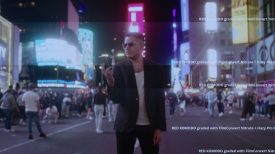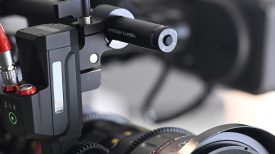By site editor Dan Chung:
When my friend Peter Kalksma of Al-Jazeera showed me this film on Vimeo the other day I was blown away. It looked like one of the best short documentaries I’d ever seen, but I wanted to find out more about how it was done. In fact, the makers don’t bill it as a documentary at all. Below Tyler Stableford talks to me about how and why he shot his stunning “visual poem”.
You come from a photography background, how has it been transitioning to a moving image?
Learning to shoot motion has been like going to graduate school, it has been very exciting to be on a steep learning curve again. Of course there seems to be much more effort involved in creating a film project than in shooting stills, but that’s just part of the deal. I feel like I am beginning to be able to manifest my creative visions in a more powerful way than with just stills alone; the process of adding music, narration and field audio etc can magnify a viewer’s emotional connection to a piece. I was a writer and a magazine journalist before going full-time as a freelance photographer, so the recent evolution to cinematography has been a fun return to storytelling. The preproduction phase of writing, storyboarding etc is a huge part of making a film.
What gave you the original idea for the film?
The film was a co-creation with the climber Steve House, and I think we each brought our own personal experiences and visions to the project. For my part, the idea of creating a visual poem based around ice climbing began in my teens and twenties when I was having powerful experiences ice climbing; the physical and mental experiences were so powerful that I couldn’t fully digest them at the time, and they have lived inside me for decades. It wasn’t until now, at age 37, that I have the skill sets to bring these emotions to life on film.
Secondly, I was reading Steve’s book Beyond The Mountain and one of his confessions really struck me: after he had succeeded in climbing his dream route on Nanga Parbat, he returned home more empty, more broken, than when he had begun this great quest. I knew immediately there was a short film in this revelation.
The film has a very stylized look and feel, was that intentional?
Yes, in almost all of my work I’m trying to both capture and create a stylized look; a feel that is both polished and gritty at the same time. I continue to be attracted to that look, and it seems to work well for many of my commercial clients as well.
Can you talk a little about the preproduction process and the roles played by Kate Rolston and Draper White?
I could talk a lot about the preproduction process and Kate and Draper’s role! But with so many questions to answer I’ll keep this brief. Kate played two huge roles in the film; one was directing the behind-the-scenes episodes for Canon’s Digital Learning Center, showing our team’s workflow and our motivations/inspirations for the film. More importantly, she was a brilliant co-director and guide through the process; Kate worked at Grey NYC for four years before coming to work with me last year, and she brings a wealth of savvy thought and perspective. She was involved in every single step of the film from beginning to end, and I am incredibly lucky to have her on our team. Equally, my first assistant and partner cinematographer Draper White, who has worked with me for 7 years, was a huge part of this film, and roughly half of the film’s visuals are shot with his talented eye, including almost all of my favorite environmental clips.
Why did you choose to shoot it on the 1D X?
This was a Canon-sponsored project, both the film and the behind-the-scenes features, to help promote the EOS-1D X camera. Kate and I pitched the idea to them this winter, as I was really excited about the new camera and wanted to have a chance to really work with it. I also shot a range of stills during the project that will be used for print campaign purposes, and this camera is just exceptional in its ability to shoot 12fps stills as well as HD video. What’s more, it was the perfect camera to withstand the harsh conditions that we used it in.
You obviously climb yourself, did you have any special concerns about shooting the film? Were there a lot of special safety precautions?
Yes, there were definitely lots of safety precautions; and the best decision I made was to hire the professional climber Hayden Kennedy to be our safety rigger. He had the hardest job of all, rigging the ropes and working 100 feet up the ice route during both days of filming, freezing his butt off without much chance to come down and warm up. He really looked out for all of us, and belayed Steve during the sequences where Steve was up high on the route.
You hide the fact that your subject Steve is using a safety rope in the finished film, did you discuss the ethics of that during the production process? do you see the film as a kind of documentary or more of a advertising type shoot?
This is a great question and one that we have discussed before launching the film. First, let me be clear that this film is intended entirely as a fictional short film. And that’s what really excited us from the beginning: to create a visual poem, one that steps into the ethereal world of art for art’s sake. It allowed us to script and reshoot scenes many times over, from different perspectives, to magnify the visual power of the film. Steve is of course a heralded and deeply respected climber and it’s important for all of us to be clear that Shattered is not a documentary. It is a commercial project, yet a deeply personal project, one in which both Steve and I invested so much of the truest experiences in our lives; and that, for us, is the beauty of it.
The desire for transparency is also a big reason why we attached the three behind-the-scenes features to the film on Vimeo and Canon’s Digital Learning Center. We discuss the scripting of the entire shoot and our intentions to create a visual poem; we show the use of Steve’s safety ropes and the shooting/reshooting of various scenes as well as the voiceover.
Since you ask the question, I’d be interested in turning it back at you; do you feel the film description online needs to be labeled more clearly as fiction? I’ve looked for precedent for this, and what I see is that documentaries are labeled as such, and fictional short films are labeled simply as short films. The last thing we want to do is be unclear with our intentions for the film, so I am open to clarifying this if needed.
The shooting environment was very harsh; what advantages did shooting on DSLR cameras give you?
I have always turned to DSLR cameras for working in challenging environments; as seen in the second behind-the-scenes episode, I could put my entire film kit in a hip bag, and go up on the route to shoot for hours. That’s a big revolution. I view the creative process of shooting similar to alpine climbing: if you bring too much gear, you become overburdened and fail to reach the summit. There is a delicate balance of having just the right gear to be able to move quickly.
Quite a few of the shots are done with a tilt-shift lens. Can you explain the thinking behind that?
We used the tilt-shift lenses to give the ice and mountains overhead a blurry, ghostly appearance. The lenses help make the ice overhead feel looming — I didn’t want the viewers to be able to see clearly up the route while Steve is approaching it, because at this point in the film, Steve isn’t seeing clearly up the route, he is immersed in tempestuous thought. This film is about an inner journey, not a happy celebration of the great outdoors, and as such the visuals needed to convey a sense of heaviness. These lenses were great for helping create a more narrow focus.
As an aside, we shot this film on Bridal Veil Falls in Telluride, but the actual location had nothing to do with the film; we could have shot in Norway or Canada, it doesn’t matter — the visuals are only vehicles to support Steve’s narrative, to carry the viewer on an emotional journey.
You also used a R/C helicopter which crashed with a 1D X onboard during the shoot, was that a scary moment? do you think heli-based shooting will become a regular feature of your work?
It wasn’t a scary moment, as we break gear all the time on shoots; it was just a disappointing moment as we had invested a heck of a lot of time and resources to make this RC helicopter moment happen, and then it crashed 20 seconds after takeoff. Drat! But yes, RC helicopters will very likely become a regular part of our workflow; we used one again on a shoot two weeks later with great success.
In hindsight would you do it again on DSLR or would you prefer to use a camera like the C300 or C500?
I would definitely use a DSLR again as it’s crucial to keep my equipment as nimble as possible during a climbing shoot. This agility is what allows creativity, and it’s why I love working with DLSR cameras in fast-moving situations.
How long did it take you to shoot?
We shot for two days, plus another day for accompanying stills and voiceovers.
Why did you choose to do voice over vs interview?
This was all part of our intention to create a visual poem. This is not a documentary, and as such we had the liberties to really play with Steve’s voiceover; and we spent literally months discussing the narration before we recorded it.
Audio plays a central role in the video, can you talk a bit about that process and the gear you used? How did you work around the 1D X not having a headphone jack?
Yes, audio is a huge component of this film; and again, this was such a fun part of creating the art — the sounds of wind moving through trees, over ice and stone, can be incredibly powerful. Similarly with Steve’s breathing, and the sounds of steel ice axes slamming into the ice. I knew that we needed true field audio to capture these sounds appropriately, so we used a Lectrosonics SMQV wireless lav on Steve, tucked under his helmet. We also used a Sennheiser MKH-416 Shotgun Mic mated to a Sennheiser SKP 2000-XP wireless transmitter, so we could be free of cords and transmit the audio to our Edirol R-44 field audio recorder. You can learn more about our field audio setup in episode 2 of the BTS video.
I would of course loved to have a headphone jack on the 1D X, I am sorry to see it missing. That said, almost all of our audio was controlled by Ben Thomas as our field audio tech, so it wasn’t a big deal.
How big was your crew?
We had a crew of 8, all told, and that included two to three people to shoot the BTS features.
What sort of budget did you have for the film?
It was well under $50k, and I ended up covering some of the expenses to finish the film at the level I wanted. Yet I see this as a portfolio piece and I’m happy to invest in the project. I feel incredibly fortunate to have had Canon’s support for this dream project.
How long did it take you to edit? Can you talk a bit about that process?
Editing always takes longer than anticipated! But there’s also a beauty in that; all of us on the team invested so much of ourselves in the project that we wanted to be sure the edited project was as good as possible. One of the hardest parts was winnowing down all the material. We shot an entire morning with scenes that we didn’t use; gorgeous macro shots of Steve filing his ice axes in front of a woodstove in a rustic cabin. Fire, serrated steel, fingertips on the blade, etc. But ultimately we cut this as it made the intro longer than needed. Stuff like this took hours if not days to consider. Yet there is power in the reduction.
Can you sum up what you like about the 1D X as a video camera? how does it compare to other DSLRs you have used?
The 1D X was an amazing video camera for this project, in that it’s built like a tank; it’s fully weather sealed, along with all of Canon’s L-series lenses, so it could stand up not just to the abuses of cold weather and snow, but also to the heavy condensation that occurred when bringing the camera back into the condo each night as it warmed up. It also shot 12 fps stills, which is wonderful for capturing action sequences.
Another huge leap on this camera is the low light ability. We shot at ISOs as high as 25,600 with great results, and that just blew my mind. The camera could see better than our eyes, truly.
And the new ALL-I compression codec is a huge leap forward. The files from this camera have greater dynamic range, and also hold up better to the push-pull process of color grading than Canon’s previous generation of cameras.
Have you tried the EOS-1D C yet? Does that camera interest you?
I haven’t yet I would love to. It definitely interests me. Pretty much every new high-end camera interests me if it allows us to do more with less. Art happens when we are unencumbered by our tools.
Is there anything else you would like to add?
I’m just very thankful for the opportunity to share our work with you and your readers. Thank you for your interest in our project.
You can see more of Tyler’s work on his website www.tylerstableford.com.






